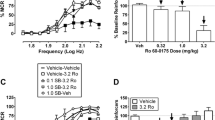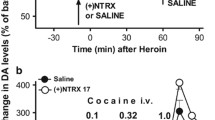Abstract
In rats tested during their first exposure to a Behavioral Pattern Monitor chamber, acute injections of the 5HT-2 agonists mescaline, quipazine, 2,5-dimethoxy-4-iodoamphetamine (DOI), 2,5-dimethoxy-4-methylamphetamine (DOM), or 2,5-dimethoxy-4-ethylamphetamine (DOET) produced an inhibition of locomotor and investigatory behavior during the first 30 min of the test session. This suppression of exploratory behavior was attenuated when rats were familiarized with the testing chamber prior to the administration of DOI. Hence, as previously observed with both LSD and DOM, 5HT-2 agonists appear to potentiate the normal neophobic reaction to a novel environment. The mixed 5HT-1 and 5HT-2 agonist 5-methoxy-N,N-dimethyltryptamine (5MeODMT) also produced a decrease in activity when animals were tested in the novel environment. However, as previously found with 5HT-1A agonists, this effect was unchanged when animals were tested in the familiar environment and may therefore reflect a generalized sedation. The receptor specificity of these differential effects of 5HT-1 and 5HT-2 agonists in this paradigm was tested by assessing the ability of selective 5HT-2 antagonists to block the effects of the agonists. A dose of the 5HT-2 antagonist ketanserin which had no effect by itself significantly reduced the behavioral effects of mescaline, DOM, and quipazine. Similarly, the selective 5HT-2 antagonist ritanserin blocked the effect of quipazine. In contrast, ketanserin had no significant effect on the suppression of activity produced by the 5HT-1A agonist 8-hydroxy-2(di-n-propylamino)tetralin (8OHDPAT). These results demonstrate that the behavioral effects of 5HT-1 and 5HT-2 agonists can be differentiated both phenomenologically and pharmacologically within a single paradigm. The findings provide further support for the hypothesis that the potentiation of neophobia produced by hallucinogens in rats is attributable to their agonist actions at 5HT-2 receptors.
Similar content being viewed by others
References
Adams LM, Geyer MA (1982) LSD-induced alterations of locomotor patterns and exploration in rats. Psychopharmacologia 77:179–185
Adams LM, Geyer MA (1985a) A proposed animal model for hallucinogens based on patterns of exploration in rats. Behav Neurosci 5:881–900
Adams LM, Geyer MA (1985b) Effects of DOM and DMT in a proposed animal model of hallucinogenic activity. Prog Neuropsychopharmacol Biol Psychiat 9:121–132
Adams LM, Geyer MA (1985c) Patterns of exploration in rats distinguish lisuride from lysergic acid diethylamide. Pharmacol Biochem Behav 23:461–468
Arvidsson L-E, Hacksell U, Nilsson JLG, Hjorth S, Carlsson A, Lindberg P, Sanchez D, Wikstrom H (1981) 8-hydroxy-2-di-n-propylamino)tetraline, a new centrally acting 5-hydroxytryptamine receptor agonist. J Med Chem 24:921–923
Blackburn TP, Kemp JD, Martin DA, Cox B (1984) Evidence that 5-HT agonist-induced rotational behaviour in the rat is mediated via 5-HT1 receptors. Psychopharmacology 83:163–165
Contreras CM, Guzman-Flores C, Mexicano G, Ervin FR, Palmour R (1984) Spike and wave complexes produced by four hallucinogenic compounds in the cat. Physiol Behav 33:981–984
Critchley MA, Handley SL (1987) Effects in the X-maze anxiety model of agents acting at 5-HT1 and 5-HT2 receptors. Psychopharmacologia 93:502–506
Cunningham KA, Appel JB (1987) Neuropharmacological reassessment of the discriminative stimulus properties ofd-lysergic acid diethylamide (LSD). Psychopharmacologia 91:67–73
Dixon WJ (1988) BMDP Statistical Software Manual. University of California Press, Los Angeles, pp 187–209, 483–519
Eide PK, Hole K, Berge OG, Brock OJ (1988) 5-HT depletion with 5,7-DHT, PCA and PCPA in mice: Differential effects on the sensitivity to 5-MeODMT, 8-OHDPAT and 5HTP as measured by 2 nociceptive tests. Brain Res 440:42–52
Fuxe K, Holmstedt B, Johnson G (1972) Effects of 5-methoxy-N,N-dimethyltryptamine on central monoamine neurons. Eur J Pharmacol 19:25–34
Gately PF, Poon SL, Segal DS, Geyer MA (1985) Depletion of brain serotonin by 5,7-dihydroxytryptamine alters the response to amphetamine and the habituation of locomotor activity in rats. Psychopharmacology 87:400–405
Geyer MA, Light RK (1979) LSD-induced alterations of investigatory responding in rats. Psychopharmacology 65:41–47
Geyer MA, Tapson GS (1988) Habituation of tactile startle is altered by drugs acting on serotonin-2 receptors. Neuropsychopharmacology 1:135–147
Geyer MA, Petersen LR, Rose GJ, Horwitt DD, Light RK, Adams LM, Zook JA, Hawkins RL, Mandell AJ (1978) The effects of lysergic acid diethylamide and mescaline-derived hallucinogens on sensory integrative function: tactile startle. J Pharmacol Exp Ther 207:837–847
Geyer MA, Light RK, Rose GJ, Petersen LR, Horwitt DD, Adams LM, Hawkins RL (1979) A characteristic effect of hallucinogens on investigatory responding of rats. Psychopharmacology 65:35–40
Geyer MA, Russo PV, Masten VL (1986) Multivariate assessment of locomotor behavior: pharmacological and behavioral analyses. Pharmacol Biochem Behav 25:277–288
Glennon RA, Young R, Rosecrans JA (1983) Antagonism of the effects of the hallucinogen DOM and the purported 5-HT agonist quipazine by 5-HT2 antagonists. Eur J Pharmacol 91:189–196
Gold LH, Koob GF, Geyer MA (1988) Stimulant and hallucinogenic behavioral profile of 3,4-methylenedioxymethamphetamine and n-ethyl-3,4-methylenedioxyamphetamine in rats. J Pharmacol Exp Ther 247:547–555
Goodwin GM, Green AR (1985) A behavioural and biochemical study in mice and rats of putative selective agonists and antagonists for 5-HT1 and 5-HT2 receptors. Br J Pharmacol 84:743–753
Grahame-Smith DG (1971) Inhibitory effect of chlorpromazine on the syndrome of hyperactivity produced byl-tryptophan or 5-methoxy-N,N-dimethyltryptamine in rats treated with a monoamine oxidase inhibitor. Br J Pharmacol 43:856–864
Heym J, Jacobs BL (1988) 5HT-2 agonist activity as a common action of hallucinogens. In: Rech RH, Gudelsky GA (eds) 5-HT agonists as psychoactive drugs. NPP Books, Ann Arbor, pp 95–106
Janssen PF, Laduron PM (1985) Receptor-binding properties in vitro and in vivo of ritanserin: a very potent and long acting serotonin-S2 antagonist. Mol Pharmacol 27:600–611
Leysen JE, Awouters F, Kennis L, Laduron PM, Vandenberk J, Janssen PA (1981) Receptor binding profile of R 41 468, a novel antagonist at 5HT2 receptors. Life Sci 28:1015–1022
Leysen JE, Eens A, Gommeren W, van Gompel P, Wynants J, Janssen PA (1988) Identification of nonserotonergic [3H]ketanserin binding sites associated with nerve terminals in rat brain and with platelets; relation with release of biogenic amine metabolites induced by ketanserin- and tetrabenazine-like drugs. J Pharmacol Exp Ther 244:310–321
Mandell AJ, Geyer MA (1976) Hallucinations: chemical and physiological. In: Grenell RG, Gabay S (eds) Biological foundations of psychiatry. Raven Press, New York, pp 729–754
Mittman SM, Geyer MA (1989) Effects of 5HT-1A agonists on locomotor and investigatory behaviors in rats differ from those of hallucinogens. Psychopharmacology 98:321–329
Mokler DJ, Commissaris RL, Henck JW, Rech RH (1984) Naloxone alters the effects of LSD, DOM and quipazine on operant behavior of rats. Pharmacol Biochem Behav 21:333–337
Murphy RM, Zemlan FP (1988) Selective 5-HT1B agonists identify the 5-HT autoreceptor in lumbar spinal cord of rat. Neuropharmacology 27:37–42
Peroutka SJ (1988) Species variation in 5-HT3 recognition sites labeled by 3H-quipazine in the central nervous system. Naunyn-Schmiedeberg's Arch Pharmacol 338:472–475
Peroutka SJ, Hamik A (1988) [3H]quipazine labels 5-HT3 recognition sites in rat cortical membranes. Eur J Pharmacol 148:297–299
Rech RH, Commissaris RL, Mokler DJ (1988) Hallucinogenic 5-hydroxytryptamine agonists characterized by disruption of operant behavior. In: Rech RH, Gudelsky GA (eds) 5-HT agonists as psychoactive drugs. NPP Books, Ann Arbor, pp 185–215
Schecter MD, Concannon JD (1982) Dopaminergic activity of quipazine. Pharmacol Biochem Behav 17:393–397
Segal DS, Geyer MA (1985) Animal models of psychopathology. In: Judd LL, Groves PM (eds) Psychobiological foundations of clinical psychiatry. Lippincott. Philadelphia, pp 1–14
Shulgin AT, Dyer DC (1975) Psychotomimetic phenylisopropylamines V: 4-alkyl-2,5-dimethoxyphenylisopropylamines. J Med Chem 18:1201–1204
Sloviter RS, Drust EG, Connor JD (1978) Evidence that serotonin mediates some behavioral effects of amphetamine. J Pharmacol Exp Ther 206:348–352
Smith LM, Peroutka SJ (1986) Differential effects of 5-hydroxytryptamine1A selective drugs on the 5-HT behavioral syndrome. Pharmacol Biochem Behav 24:1513–1519
Titeler M, Lyon RA, Glennon RA (1988) Radioligand binding evidence implicates the brain 5-HT2 receptor as a site of action for LSD and phenylisopropylamine hallucinogens. Psychopharmacology 94:213–216
Tricklebank MD, Forler C, Middlemiss DN, Fozard JR (1985) Subtypes of the 5-HT receptor mediating the behavioural responses to 5-methoxy-N,N-dimethyltryptamine in the rat. Eur J Pharmacol 118:15–24
Van Nueten JM, Janssen PA, Van Beek J, Xhonneux R, Verbeuren TJ, Vanhoutte PM (1981) Vascular effects of ketanserin (R 41 468) a novel antagonist of 5-HT2 serotonergic receptors. J Pharmacol Exp Ther 218:217–230
Author information
Authors and Affiliations
Rights and permissions
About this article
Cite this article
Wing, L.L., Tapson, G.S. & Geyer, M.A. 5HT-2 mediation of acute behavioral effects of hallucinogens in rats. Psychopharmacology 100, 417–425 (1990). https://doi.org/10.1007/BF02244617
Received:
Revised:
Issue Date:
DOI: https://doi.org/10.1007/BF02244617




